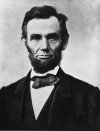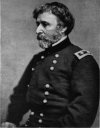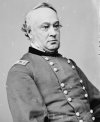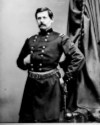
 Following the Federal defeats at the Battle of Wilson's Creek and the Battle of Lexington, the struggle for Missouri was tilting towards the South as the end of 1861 approached. President Abraham Lincoln realized that he needed a new commander in Missouri and relieved Major General John C. Fremont from command on November 2, 1861.
Following the Federal defeats at the Battle of Wilson's Creek and the Battle of Lexington, the struggle for Missouri was tilting towards the South as the end of 1861 approached. President Abraham Lincoln realized that he needed a new commander in Missouri and relieved Major General John C. Fremont from command on November 2, 1861.
On November 9, 1861, Lincoln issues orders that formed a new Department of the Missouri and placed Major General Henry W.  Halleck in command. The Department of the Missouri would include the States of Missouri, Iowa, Minnesota, Wisconsin, Illinois, Arkansas, and that portion of Kentucky west of the Cumberland River.
Halleck in command. The Department of the Missouri would include the States of Missouri, Iowa, Minnesota, Wisconsin, Illinois, Arkansas, and that portion of Kentucky west of the Cumberland River.
 Realizing that keeping Missouri in the Union would be an important and difficult assignment, Union General-in-Chief George McClellan issued the following instructions to Halleck:
Realizing that keeping Missouri in the Union would be an important and difficult assignment, Union General-in-Chief George McClellan issued the following instructions to Halleck:
“You have not merely the ordinary duties of a military commander to perform, but the far more difficult task of reducing chaos to order, of changing probably the majority of the personnel of the staff of the Department, and of reducing to a point of economy, consistent with the interests and necessities of the State, a system of reckless expenditure in th and fraud, perhaps unheard of before in the history of the world.”
“With respect to military operations, it is probable, from the best information in my possession, that the interests of the Government will be best served by fortifying and holding in considerable strength Rolla, Sedalia, and other interior points, keeping strong patrols constantly moving from the terminal stations, and concentrating the mass of the troops on or near the Mississippi, prepared for such ulterior operations as the public interests may demand.”
Major General Henry W. Halleck assumed command on November 19, 1861 and established his headquarters in St. Louis, Missouri. Halleck's actions in the Department of the Missouri would be pivotal in reclaiming the Mississippi River for the Union. In order to be able to commit enough forces to that endeavor, Halleck would need to drive Southern forces out of Missouri.
On November 27th, Halleck sent the following telegram to McClellan:
“Affairs here in complete chaos. Troops unpaid; without clothing or arms. Many never properly mustered into service and some utterly demoralized. Hospitals overflowing with sick. One division of 7,500 has over 2,000 on sick list. Five divisions still in the field – two at Rolla and three near Sedalia. Price and McCulloch said to be moving north, crossing the Osage on Sunday near Osceola, and intended to attack either Lexington or Jefferson City. Have sent out strong reconnoitering parties from Sedalia and Rolla. Some skirmishing with enemy's advance guard and flankers, but nothing certain as to position of main body. Telegraph wires all work well, and I am in hourly communication with Headquarters of divisions. All troops ordered to be in readiness to move. Price's forces estimated at from 15,000 to 23,000. Local rebels have risen in arms in Ray County and are fortifying themselves in Albany. General Prentiss ordered to move against them from Chillicothe with all the available troops of his command. ”
Halleck would need all of his administrative skills to bring order from chaos in the Department of the Missouri.

 Following the Federal defeats at the Battle of Wilson's Creek and the Battle of Lexington, the struggle for Missouri was tilting towards the South as the end of 1861 approached. President Abraham Lincoln realized that he needed a new commander in Missouri and relieved Major General John C. Fremont from command on November 2, 1861.
Following the Federal defeats at the Battle of Wilson's Creek and the Battle of Lexington, the struggle for Missouri was tilting towards the South as the end of 1861 approached. President Abraham Lincoln realized that he needed a new commander in Missouri and relieved Major General John C. Fremont from command on November 2, 1861. Halleck in command. The Department of the Missouri would include the States of Missouri, Iowa, Minnesota, Wisconsin, Illinois, Arkansas, and that portion of Kentucky west of the Cumberland River.
Halleck in command. The Department of the Missouri would include the States of Missouri, Iowa, Minnesota, Wisconsin, Illinois, Arkansas, and that portion of Kentucky west of the Cumberland River. Realizing that keeping Missouri in the Union would be an important and difficult assignment, Union General-in-Chief George McClellan issued the following instructions to Halleck:
Realizing that keeping Missouri in the Union would be an important and difficult assignment, Union General-in-Chief George McClellan issued the following instructions to Halleck: